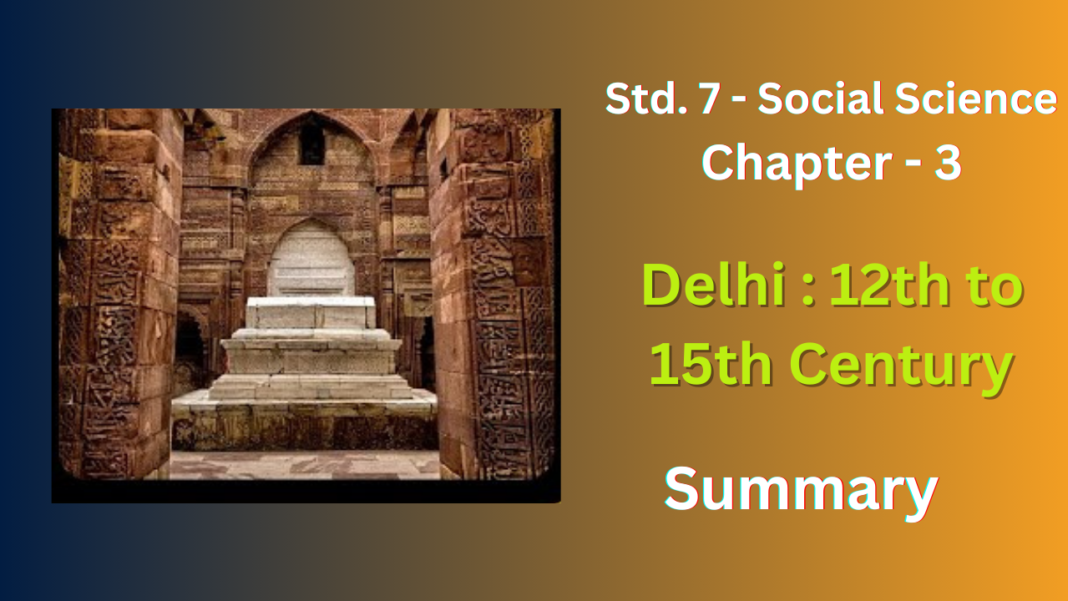NCERT Solutions for Class 7 History Chapter 3
This chapter from your 7th-grade social science textbook delves into the rich history of Delhi from the 12th to the 15th century, a period marked by the rise and fall of the Delhi Sultanate. Here’s a breakdown of the key themes you’ll encounter:
From Trading Post to Powerhouse:
- Before the 12th century, Delhi wasn’t a prominent city. It flourished under the Tomaras, who established it as a commercial center. The Chauhans further developed the city, attracting merchants with its favorable location.
The Delhi Sultanate Takes Center Stage:
- The landscape shifted dramatically in the early 13th century with the establishment of the Delhi Sultanate. This powerful empire, spanning vast territories across the subcontinent, chose Delhi as its capital.
- The chapter will likely introduce you to different dynasties that ruled under the Delhi Sultanate’s umbrella. Some prominent names you might encounter include:
- Slave Dynasty: Founded by Qutub-ud-din Aibak, this dynasty established Delhi as the permanent capital. They are known for constructing the iconic Quwwat-ul-Islam Mosque, one of the earliest examples of Indo-Islamic architecture.
- Khalji Dynasty: This dynasty, known for rulers like Alauddin Khalji, implemented innovative administrative and military reforms. Alauddin Khalji’s market regulations and price controls are a noteworthy example.
- Tughlaq Dynasty: This dynasty focused on infrastructure development and introduced a token coinage system. Muhammad bin Tughluq, a controversial figure, attempted to shift the capital but faced rebellions.
- Sayyid Dynasty: This dynasty marked a period of decline for the Delhi Sultanate before the rise of the Mughals.
Empires at Work: Administration and Challenges:
- Get ready to delve into the nitty-gritty of how these empires functioned! You’ll likely learn about:
- Administrative Systems: How the Sultans divided their territories, appointed officials, and collected taxes to maintain their vast empires.
- Military Strategies: Explore how the Sultans built and maintained powerful armies to defend their territories and expand their influence.
- Rebellions and Invasions: No empire is without its challenges. The chapter might discuss how the Sultans dealt with rebellions within their territories and external threats like Mongol invasions.
A Lasting Legacy:
- The Delhi Sultanate’s rule left an indelible mark on the subcontinent, even beyond its period of dominance. Here are some aspects of their lasting legacy:
- Political Center: Despite the rise and fall of different dynasties, Delhi remained a crucial political center for centuries to come.
- Architectural Marvels: The magnificent forts, mosques, and tombs built during this period stand as testaments to their architectural achievements. Examples include the Qutub Minar and the Red Fort.
- Cultural Blend: The interaction between the Delhi Sultans and the existing Indian culture led to a unique blend reflected in art, literature, and language. This period saw the development of Urdu.
- Trade and Commerce: The Delhi Sultanate facilitated trade within the subcontinent and with other parts of Asia and Africa.
Exploring Beyond the Textbook:
- To enrich your understanding, look out for additional resources:
- Maps depicting the extent of the Delhi Sultanate at its peak.
- Pictures or descriptions of monuments built during this period, allowing you to visualize their architectural styles.
- Online resources or library books that provide more details about specific dynasties or rulers.
Exercises
Let’s Recall
1. Which ruler first established his or her capital at Delhi?
Ans : The ruler who first established their capital at Delhi was Anangpal Tomar.
2. What was the language of administration under the Delhi Sultans?
Ans : The language of administration under the Delhi Sultans was Persian.
3. In whose reign did the Sultanate reach its farthest extent?
Ans : The Delhi Sultanate reached its farthest extent during the reign of Muhammad bin Tughlaq, who ruled from 1324 to 1351 CE.
4. From which country did Ibn Battuta travel to India?
Ans : Ibn Battuta traveled to India from Morocco.
Let’s Understand
5. According to the ‘circle of justice’ why was it important for military commanders to keep the interests of the peasantry in mind?
Ans : According to the ‘circle of justice,’ military commanders needed to consider the interests of the peasantry for two key reasons:
- Peasants: The Backbone of the Economy: Peasants were the primary source of revenue for the kingdom. They cultivated crops, raised livestock, and paid taxes that funded the military, administration, and other state functions. If the peasantry was unhappy or unable to produce due to excessive burdens, the kingdom’s income would suffer, weakening its overall strength.
- Peasants: The Source of Soldiers: In many cases, soldiers were recruited from the peasant population. Disgruntled peasants wouldn’t be motivated to fight effectively for a ruler who neglected their needs. Keeping the peasantry content ensured a steady pool of potential recruits and a more reliable military force.
6. What is meant by the ‘internal’ and ‘external’ frontiers of the Sultanate?
Ans :
Internal Frontiers: This refers to the areas surrounding the Sultanate’s capital city, Delhi, and other major garrison towns.
External Frontiers: This refers to the territories beyond the immediate vicinity of the capital and garrison towns.
7. What were the steps taken to ensure that muqtis performed their duties? Why do you think they may have wanted to defy the orders of the Sultans?
Ans : The Sultans kept muqtis (land governors) in check by appointing loyal officials, tracking tax records, and rotating assignments. Despite this, muqtis might defy orders due to their taste of power, the potential for wealth, or a chance to build their own local influence, especially during times of weak central rule.
8. What was the impact of the Mongol invasions on the Delhi Sultanate?Ans. The Delhi Sultanate mobilised a large standing army in Delhi. It posed a big administrative challenge.
Ans :
Alauddin Khalji:
- Built a new military town called Siri to house his soldiers.
- Imposed a heavy tax on land (50% of the crop yield) to feed his army.
- Introduced a cash salary system for soldiers.
Muhammad Tughluq:
- Ordered a controversial relocation of Delhi’s residents to a new city called Daulatabad in the south. This essentially turned Delhi into a military garrison town.
- Disbanded the existing army.
- Like Alauddin Khalji, he also paid soldiers in cash.
9. Do you think the authors of tawarikh would provide information about the lives of ordinary men and women?
Ans : No, it’s unlikely that the authors of tawarikh would provide much information about the lives of ordinary men and women. Here’s why:
- Focus on Rulers: Tawarikh were histories written primarily to document the achievements and events surrounding the Delhi Sultans and their courts. The lives of ordinary people weren’t considered significant enough for inclusion in these official chronicles.
- Social Status: The authors of tawarikh were themselves members of the elite class: secretaries, administrators, poets, and courtiers. Their social circles and interests likely revolved around the Sultanate’s power structure, not the daily lives of commoners.
- Limited Sources: Information for tawarikh came from court records, eyewitness accounts of events, and official pronouncements. Ordinary people wouldn’t have had a voice in these sources.
10. Raziyya Sultan was unique in the history of the Delhi Sultanate. Do you think women leaders are accepted more readily today?
Ans : Razia Sultan, the only female ruler of Delhi, defied the norms of her time. Today, women leaders are more accepted, but achieving equality in leadership roles globally remains a work in progress. Razia’s story inspires us to keep moving forward.
11. Why were the Delhi Sultans interested in cutting down forests? Does deforestation occur for the same reasons today?
Ans : The Delhi Sultans chopped down forests to make way for farms, towns, and trade routes. Today, deforestation is more about industrial needs, growing cities, and cash crops.
NCERT Solutions for Class 7 History Chapter 3
FAQ’s
What topics are covered in NCERT Solutions for Class 7 History Chapter 3?
NCERT Solutions for Class 7 History Chapter 3 delve into the historical narrative of Delhi from the 12th to the 15th century, exploring its political, cultural, and architectural aspects during this period.
How can NCERT Solutions for Class 7 History Chapter 3 benefit students?
NCERT Solutions for Class 7 History Chapter 3 provide a comprehensive understanding of the evolution of Delhi, offering valuable insights into its rich history and cultural heritage.
Are the NCERT Solutions for Class 7 History Chapter 3 easy to understand?
Yes, the NCERT Solutions for Class 7 History Chapter 3 are designed to be easily comprehensible, providing clear explanations and elucidating historical concepts for students.
Can NCERT Solutions for Class 7 History Chapter 3 help in exam preparation?
Absolutely, NCERT Solutions for Class 7 History Chapter 3 offer detailed explanations and answers that can greatly aid students in their exam preparation, ensuring a thorough grasp of historical concepts.
Where can I find NCERT Solutions for Class 7 History Chapter ?
You can access NCERT Solutions for Class 7 History Chapter 3 on Education85’s website, providing comprehensive and accurate resources for your history studies.









